Special Report
Every Major US City's Worst Weather Event

Published:
Last Updated:

Extreme weather events are becoming more frequent in the United States, and they appear to be intensifying because of climate change. Because of the sheer size of America, different cities in the United States can be hit by virtually any intense weather occurrence, including drought, floods, deep freezes, blizzards, tropical cyclones, wildfires, and tornadoes.
To identify the worst weather event in each major U.S. city, 24/7 Tempo looked at extreme weather events ever recorded in the 50 most populous cities in the country. Data on these weather events were taken from sources that included news reports and federal agencies such as the National Oceanic and Atmospheric Association (NOAA).
Click here to read about every major U.S. city’s worst weather event
In the last decade, there have been 111 climate-related natural disasters that have caused at least $1 billion in damages nationwide. In the previous decade, there were only 59 such events. The frequency and intensity of these events have profound implications for the economic, demographic, and cultural future of American cities These are the worst natural disasters in the US in the last 10 years.
Different parts of the nation face different kinds of extreme weather. Cities in the Plains and Great Lake states have fallen victim to blizzards and tornadoes. The West Coast is at risk of wildfires. The Southwest has been devastated by prolonged drought. The South is frequently hit with tornadoes and hurricanes. Blizzards and hurricanes have also ravaged the East Coast. Midwestern areas near rivers are often inundated with massive floods. Here are the worst floods in American history.
To identify the worst weather event in each major US city, 24/7 Tempo looked at extreme weather events throughout our nation’s history in the 50 most populous cities in the country with the most fatalities, property damage, the magnitude of the event, or any combination of the three. Data on these weather events were taken from sources ranging from local news reports to federal sources such as the National Oceanic and Atmospheric Association (NOAA). We looked at the 50 largest cities in the country, according to the American Community Survey 2018 1-Year Estimates.
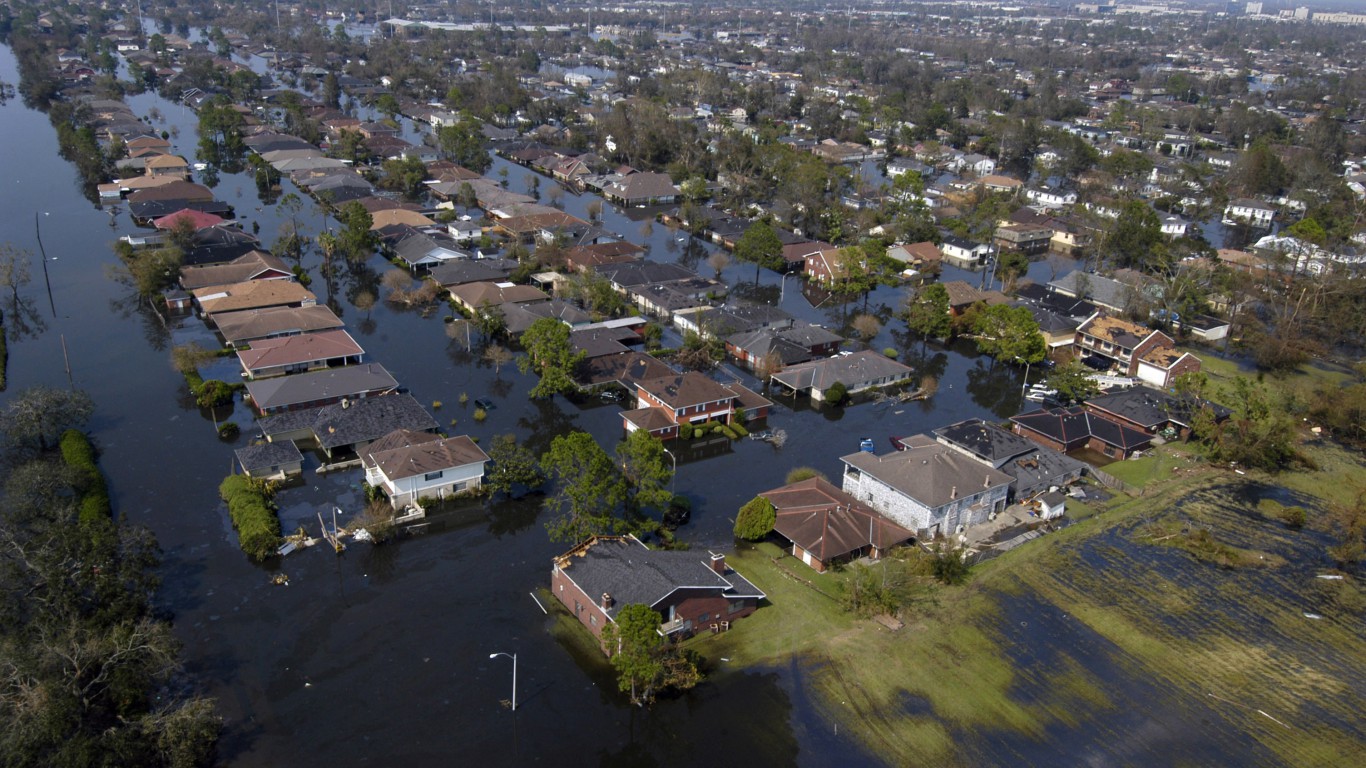
50. New Orleans, Louisiana
> Total 2018 population: 391,006
> Name of event: Hurricane Katrina in 2005
> Fatalities: 1,200
Hurricane Katrina battered New Orleans in 2005 and about 70% of the city’s occupied housing, 134,000 units, were damaged in the storm.
[in-text-ad]

49. Tampa, Florida
> Total 2018 population: 392,890
> Name of event: Hurricane in 1848
> Fatalities: Unknown
The Tampa Bay hurricane of 1848 was called the Great Gale. It struck the city in September and wiped out the citrus crops.
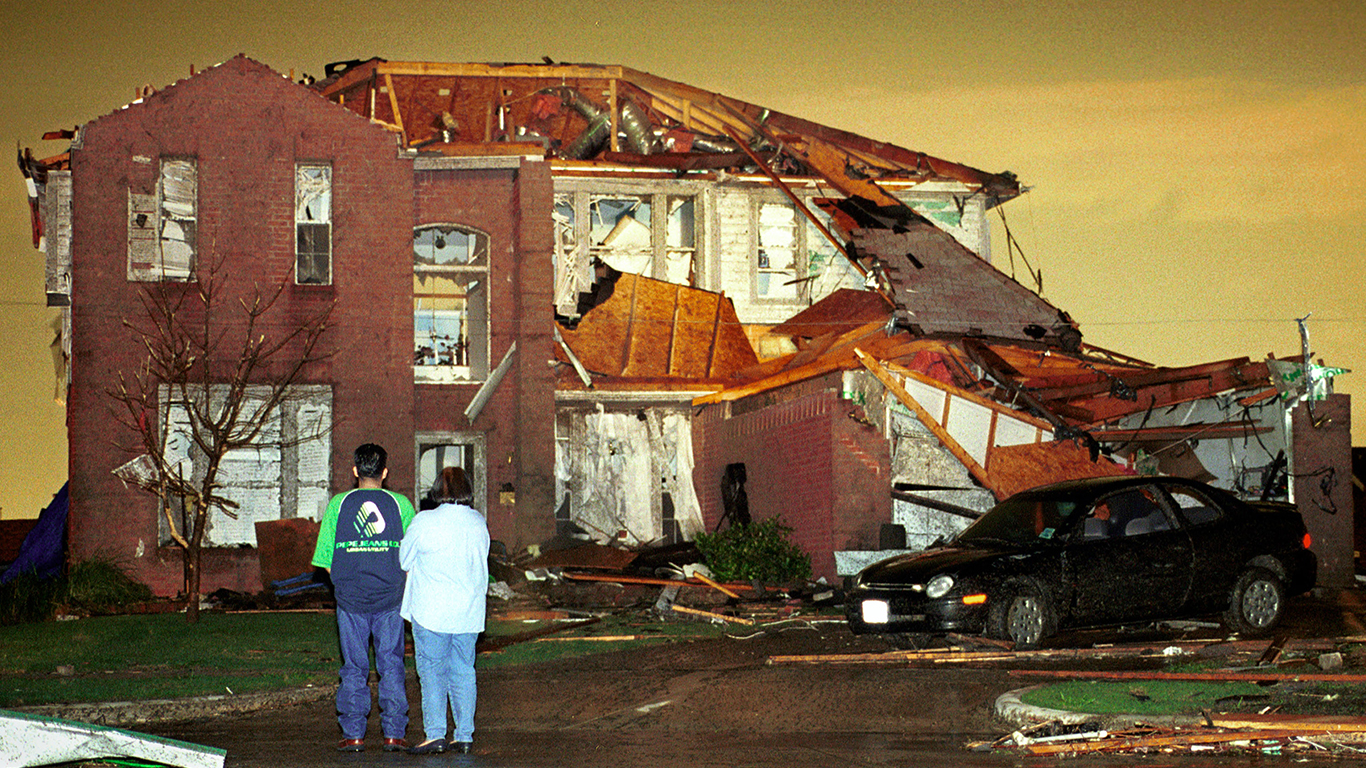
48. Arlington, Texas
> Total 2018 population: 398,112
> Name of event: Tornado in 2000
> Fatalities: 5 in region
A tornado blasted the Fort Worth-Arlington-Grand Prairie region in March of 2000, causing property damage estimated at $500 million.

47. Tulsa, Oklahoma
> Total 2018 population: 400,669
> Name of event: Tornado in 1974
> Fatalities: 1, over a dozen statewide
A tornado in 1974 in Tulsa and accompanying flooding caused about $212 million in damage.
[in-text-ad-2]
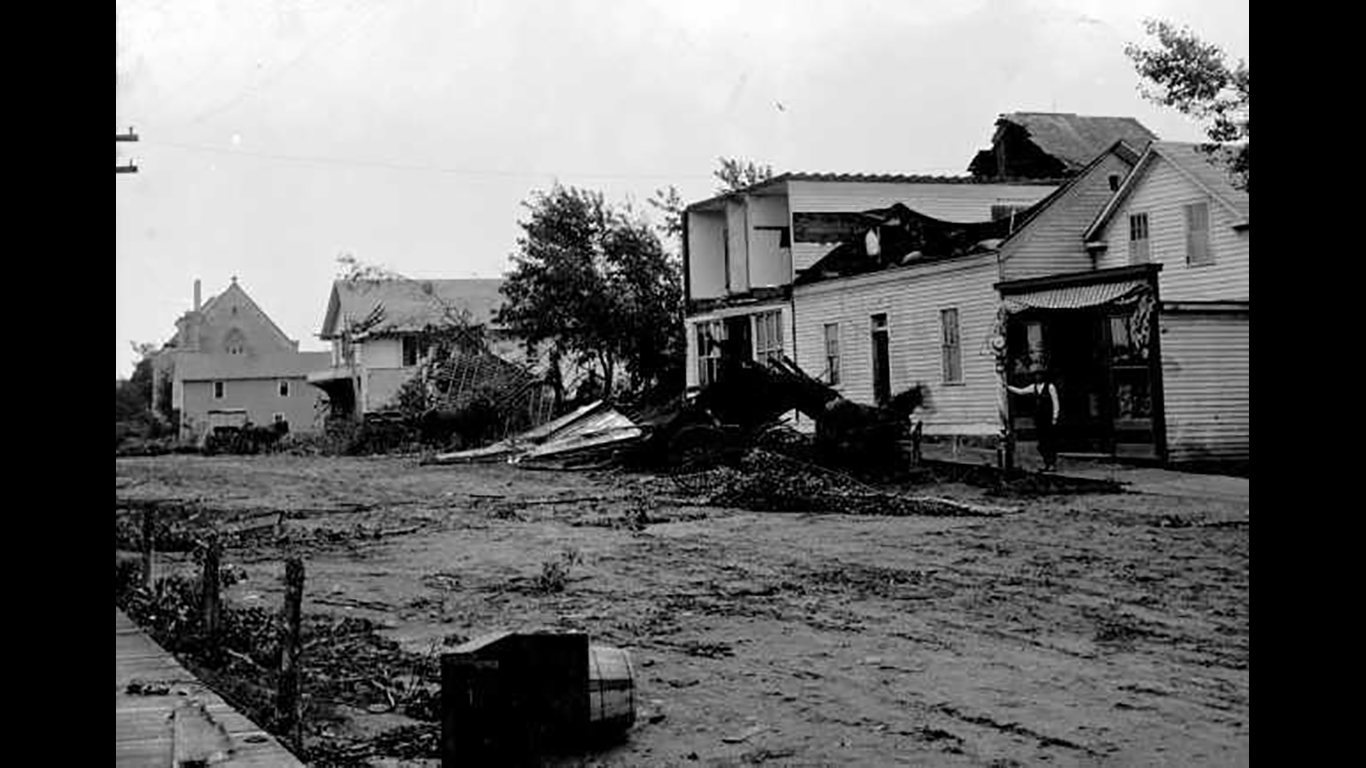
46. Minneapolis/St. Paul, Minnesota
> Total 2018 population: 425,403
> Name of event: Tornado in 1904
> Fatalities: 16
A tornado slammed into the twin cities on Aug. 21,1904 and devastated the business districts of St. Paul.

45. Oakland, California
> Total 2018 population: 429,082
> Name of event: Fire caused by drought in 1991
> Fatalities: 25
Drought and heavy winds in October of 1991 stoked a brush fire into a major conflagration near Oakland and Berkeley. The fire eventually spread to 1,500 acres.
[in-text-ad]
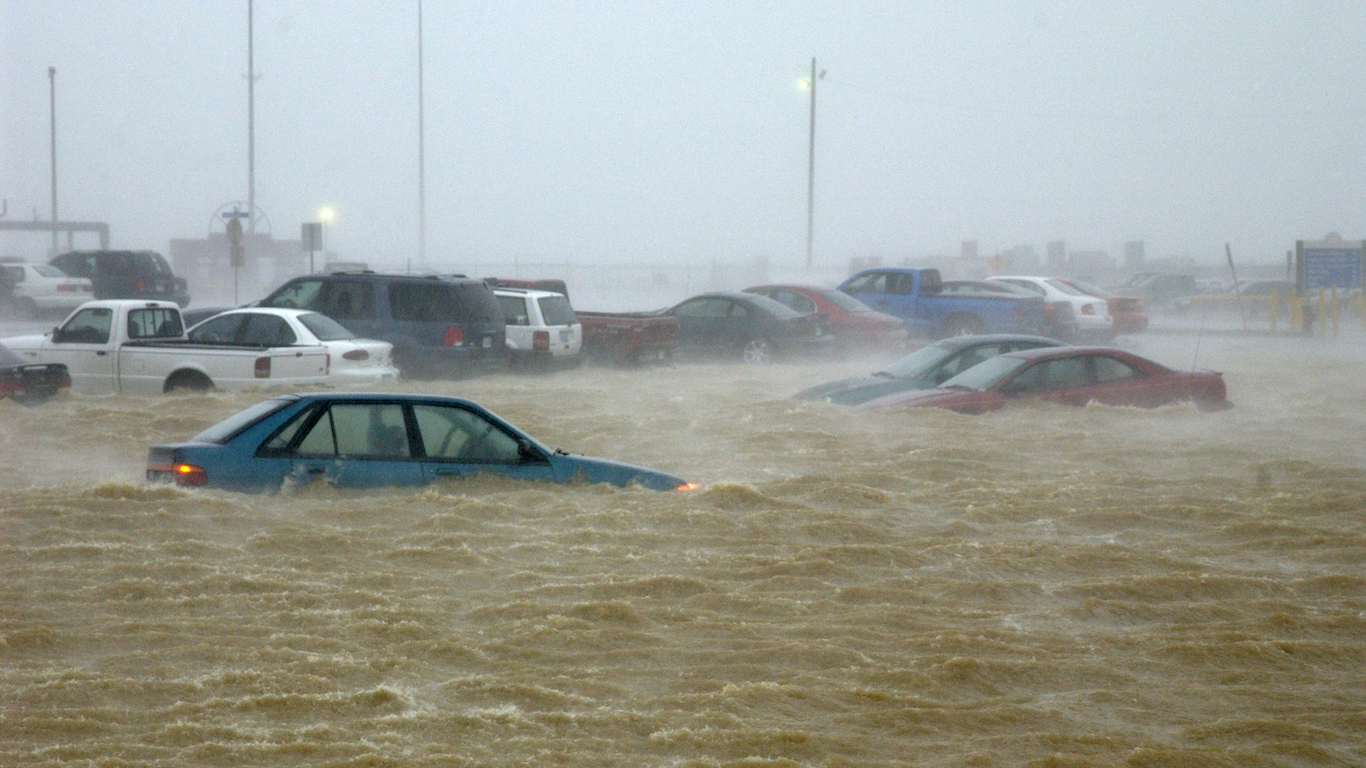
44. Virginia Beach, Virginia
> Total 2018 population: 450,189
> Name of event: Hurricane Isabel 2003
> Fatalities: 32
Hurricane Isabel, once a Category 5 storm, made landfall on Sept. 18, 2003 and eventually caused more than $2.4 billion in damages in the region, including Virginia Beach.

43. Long Beach, California
> Total 2018 population: 467,354
> Name of event: Hurricane in 1939
> Fatalities: About 100
The only cyclone to make landfall in California in the 20th century pummeled Long Beach in 1939 causing torrential rainfall and flooding.
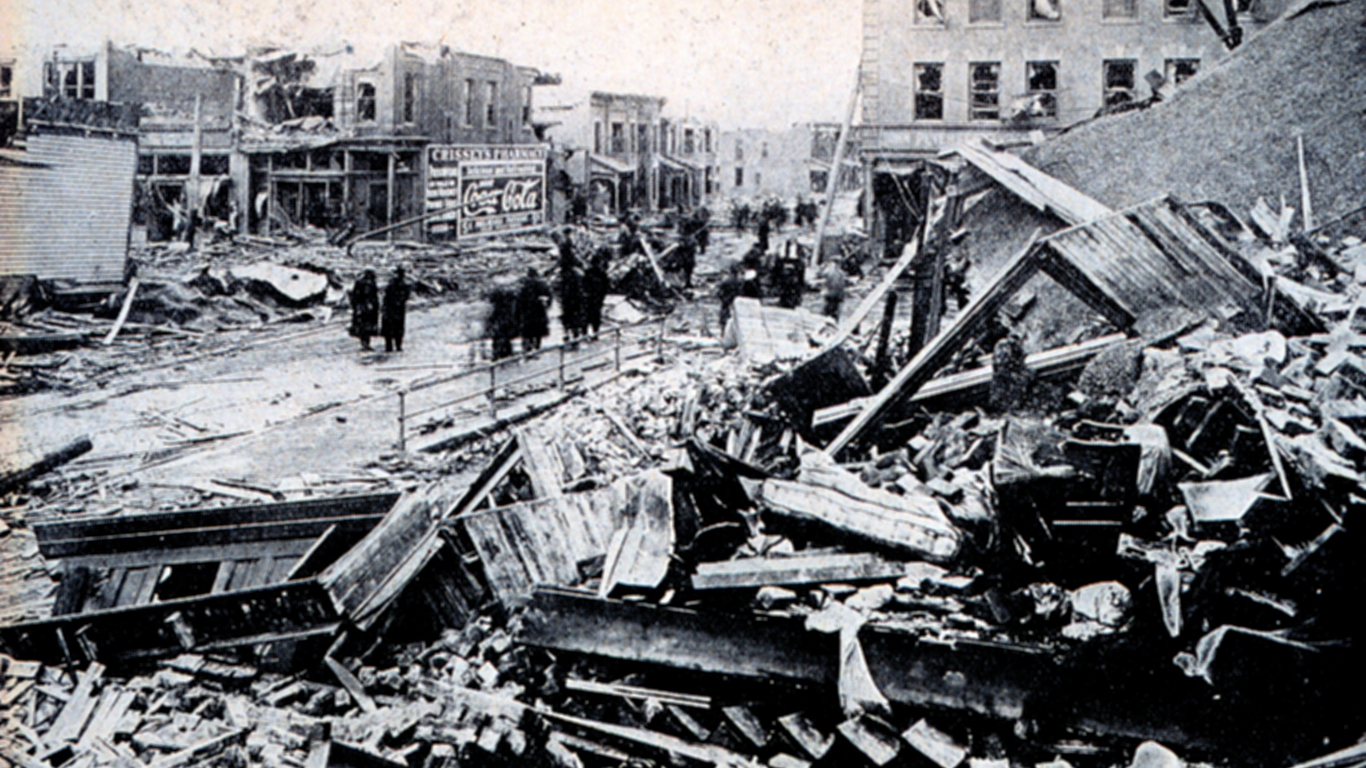
42. Omaha, Nebraska
> Total 2018 population: 468,262
> Name of event: Tornadoes in 1913
> Fatalities: 94
An outbreak of tornadoes in 1913 caused $250 million in damage in the Omaha area.
[in-text-ad-2]
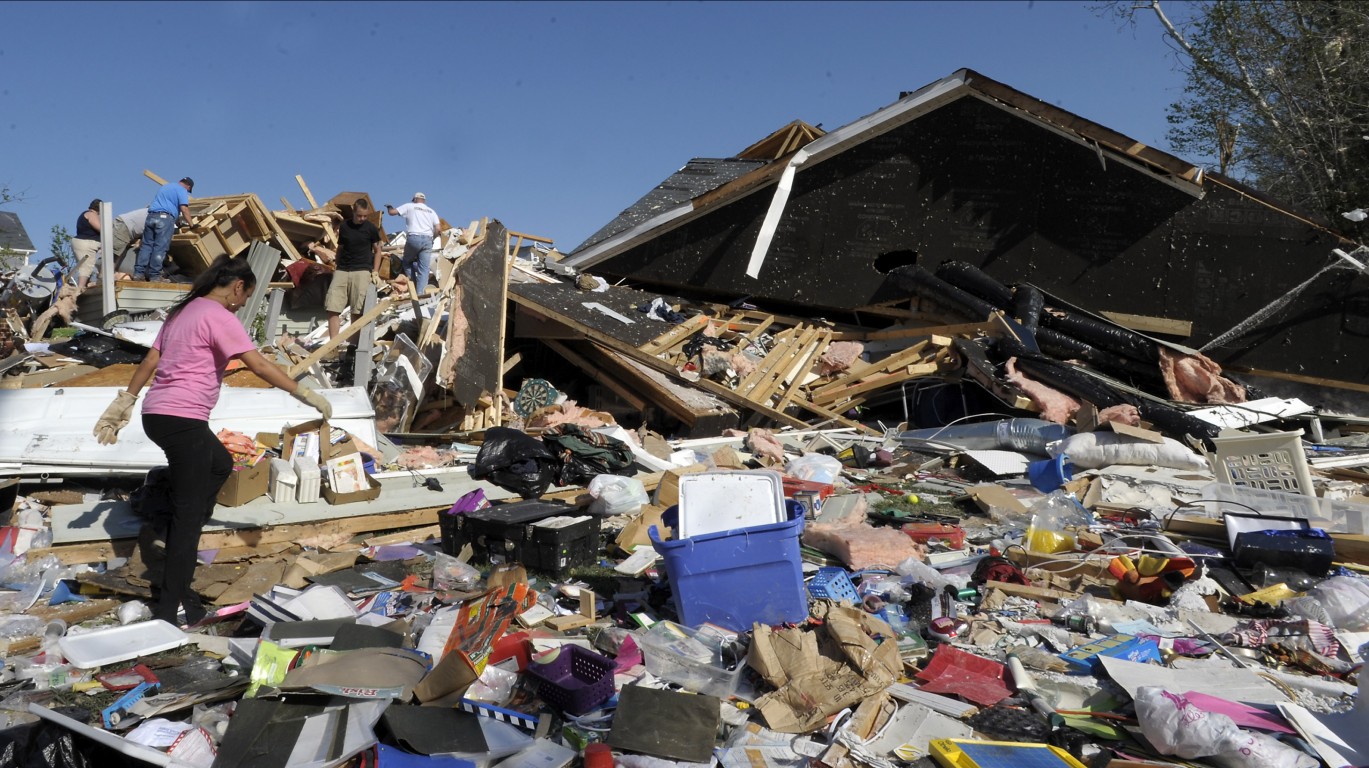
41. Raleigh, North Carolina
> Total 2018 population: 469,298
> Name of event: 2011 tornado outbreak
> Fatalities: 24 in North Carolina
Thirty tornadoes touched down in North Carolina in April 2011, one of which took aim at Raleigh, packing wind speeds of 160 mph.
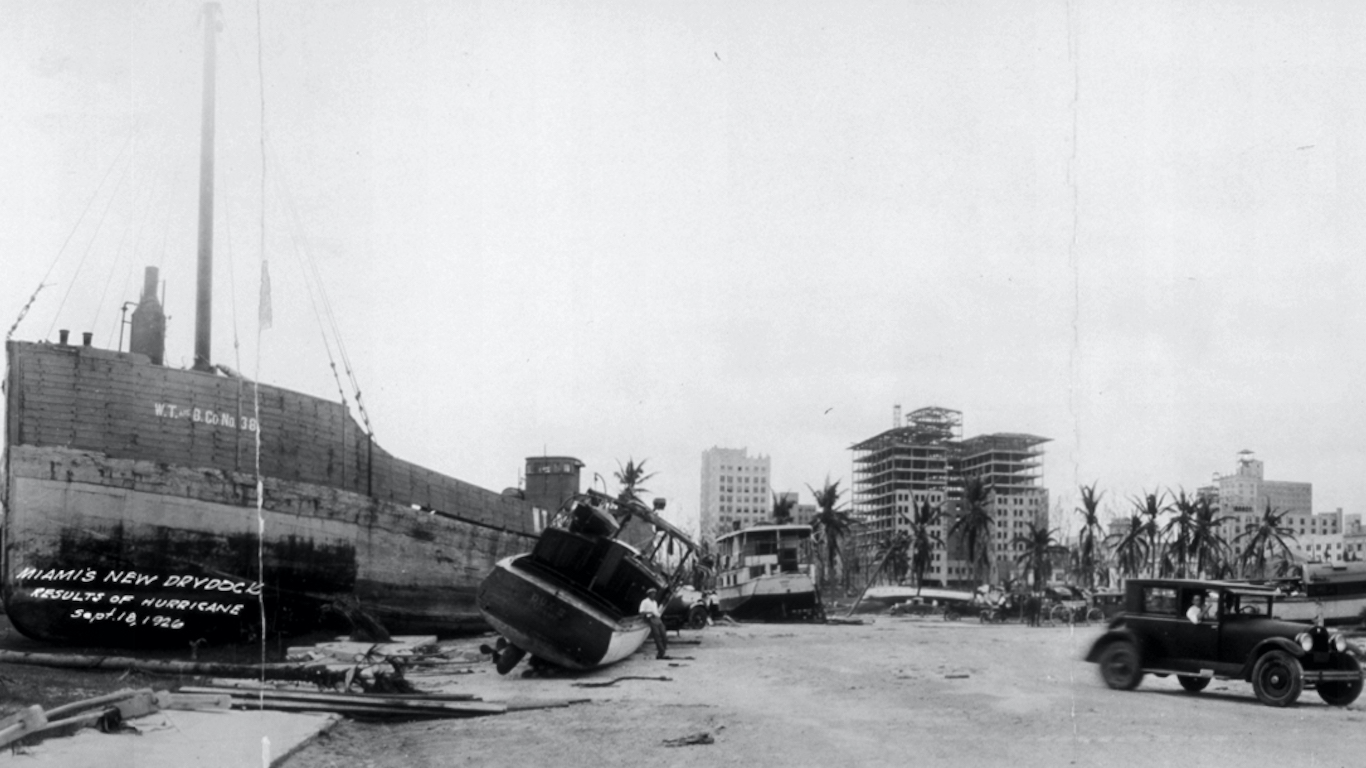
40. Miami, Florida
> Total 2018 population: 470,914
> Name of event: Hurricane in 1926
> Fatalities: 373
The hurricane of 1926 was a Category 4 cyclone that caused $164.8 billion in damage (adjusted for inflation).
[in-text-ad]

39. Colorado Springs, Colorado
> Total 2018 population: 472,688
> Name of event: The 2013 Front Range Floods
> Fatalities: 8
Flooding in Colorado Springs in 2013 forced thousands of people to flee and destroyed homes and farms.

38. Kansas City, Missouri
> Total 2018 population: 491,918
> Name of event: Tornado outbreak in 1957
> Fatalities: 37 in Missouri
The Ruskin Heights Tornado, named after the Kansas City neighborhood it impacted, was one of 35 tornadoes that touched down in Colorado, Kansas, Nebraska, Oklahoma, and Missouri on May 20, 1957.

37. Atlanta, Georgia
> Total 2018 population: 498,044
> Name of event: 500-year flood from continuous rain in 2009
> Fatalities: 10
What Georgia residents called a 500-year flood in 2009 caused $500 million in damage.
[in-text-ad-2]

36. Sacramento, California
> Total 2018 population: 508,529
> Name of event: Great Flood of 1862
> Fatalities: Unknown due to lack of records
The capital of California was under water for months because of torrential rain, and the state government was forced to relocate to San Francisco.

35. Mesa, Arizona
> Total 2018 population: 508,958
> Name of event: Flood in 2014
> Fatalities: None
A flood in the Arizona town resulted from 3.29 inches of rain that fell in one day — on Sept. 8, 2014.
[in-text-ad]

34. Fresno, California
> Total 2018 population: 530,093
> Name of event: Great Flood of 1862
> Fatalities: Unknown due to lack of records
Like much of California, Fresno was inundated by flooding that followed colossal storms in 1862.

33. Tucson, Arizona
> Total 2018 population: 545,975
> Name of event: 1983 flooding caused by Hurricane Octave
> Fatalities: 14
Flooding that followed the arrival of Hurricane Octave in 1983 uprooted 10,000 people and caused more than $1 billion in damages, adjusted for inflation.

32. Albuquerque, New Mexico
> Total 2018 population: 560,218
> Name of event: Flooding in 1941
> Fatalities: 28
Flooding around the New Mexico city in 1941 caused $55 million in damage, adjusted for inflation.
[in-text-ad-2]
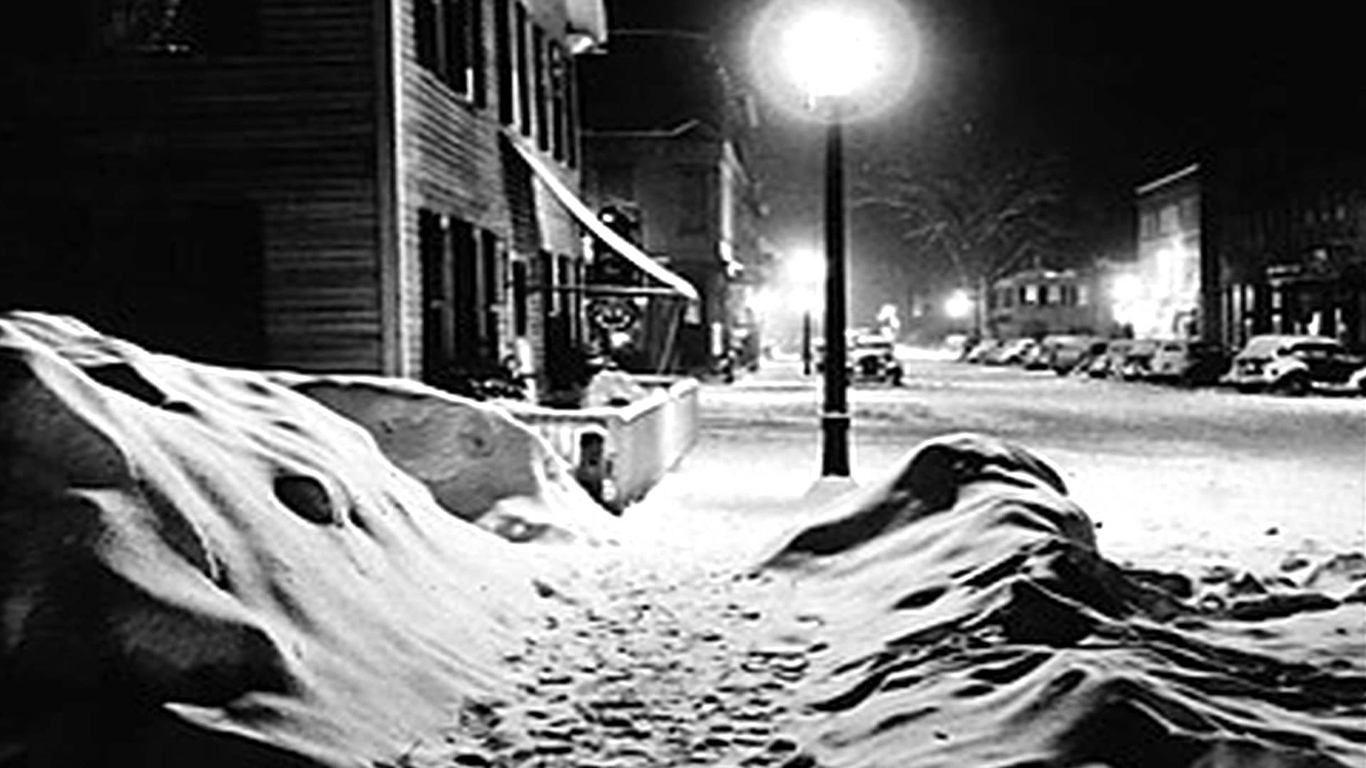
31. Milwaukee, Wisconsin
> Total 2018 population: 592,025
> Name of event: The Armistice Day Blizzard
> Fatalities: 13
The Armistice Day Blizzard of 1940 was a massive storm that swept over Minnesota, Wisconsin, Illinois, and Michigan, killing people and livestock, with winds reaching 54 mph in Milwaukee.

30. Baltimore, Maryland
> Total 2018 population: 602,495
> Name of event: Hurricane Isabel
> Fatalities: 2
In September 2003, Hurricane Isabel blasted the Maryland-Virginia-Washington, D.C. area with winds of up to 105 mph after it made landfall.
[in-text-ad]

29. Louisville/Jefferson County, Kentucky
> Total 2018 population: 620,118
> Name of event: The 1974 Tornado Outbreak
> Fatalities: 2 dead, 200 injured
The Louisville/Jefferson County, Kentucky area was hit by part of a 148-tornado outbreak in 13 states in April of 1974.
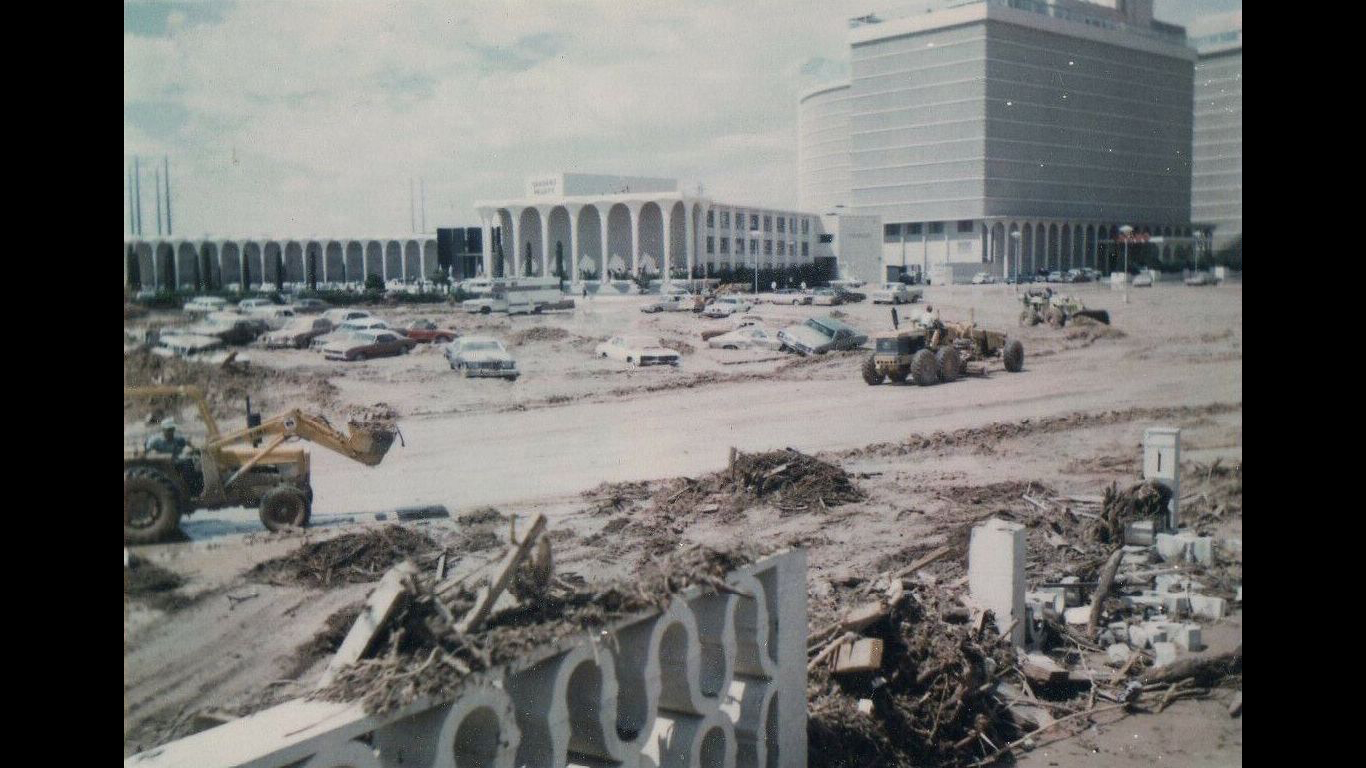
28. Las Vegas, Nevada
> Total 2018 population: 644,644
> Name of event: The 1975 Flash Flood
> Fatalities: 2
Major thunderstorm activity led to heavy floods in Las Vegas in 1975, with some areas getting 3 inches on July 3.

27. Oklahoma City, Oklahoma
> Total 2018 population: 649,021
> Name of event: 1999 Tornado Outbreak
> Fatalities: 36
On May 3, 1999, a supercell of 74 tornadoes took aim at Oklahoma and Kansas. The tornadoes caused over $1 billion in damage, including devastation in Oklahoma City.
[in-text-ad-2]

26. Memphis, Tennessee
> Total 2018 population: 650,618
> Name of event: The Super Tuesday Tornado Outbreak of 2008
> Fatalities: 9
The Super Tuesday Tornado Outbreak in February of 2008 caused an estimated damage of $520 million.
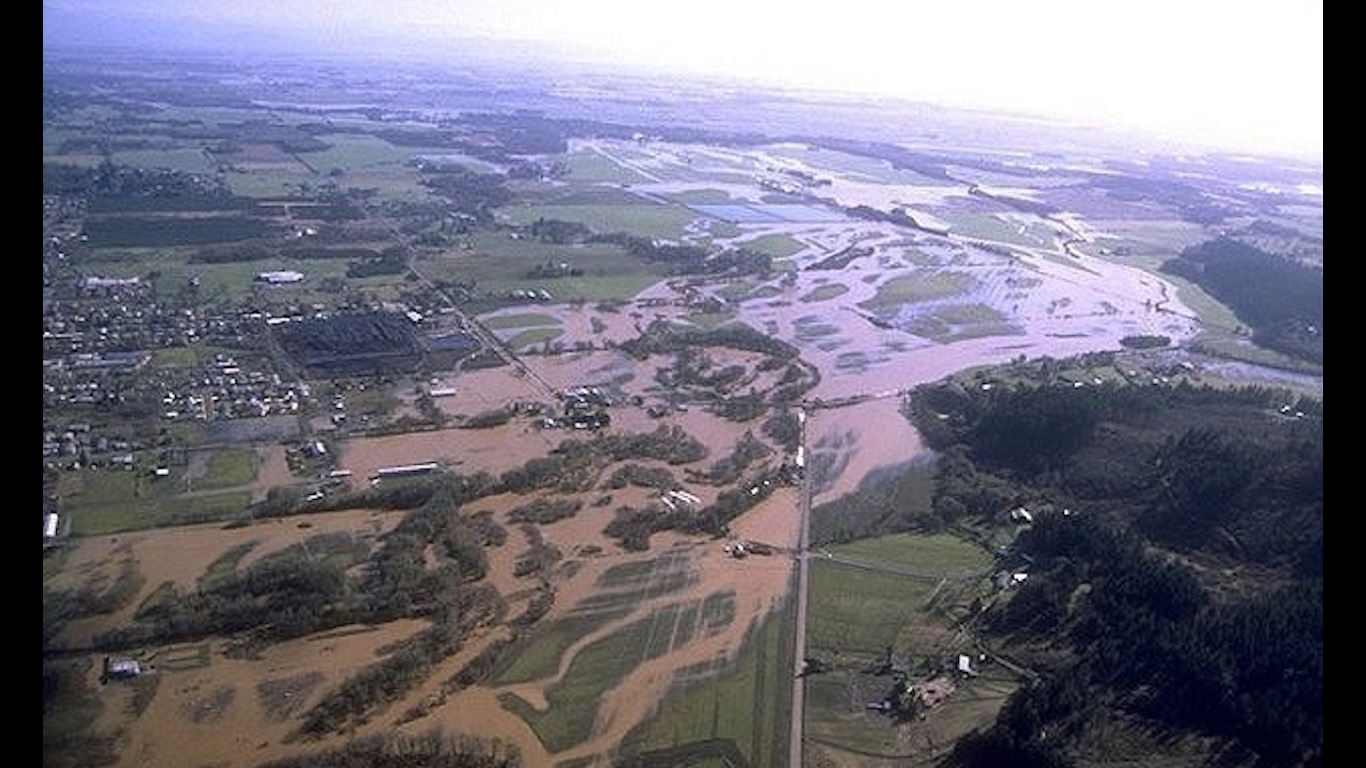
25. Portland, Oregon
> Total 2018 population: 653,115
> Name of event: Willamette Valley flood in 1996
> Fatalities: 8
The Pineapple Express jetstream that came into Oregon in February of 1996 melted snow and dumped much rain on the region, causing a deadly flood.
[in-text-ad]

24. Nashville-Davidson, Tennessee
> Total 2018 population: 669,053
> Name of event: Nashville flood in 2010
> Fatalities: 11 in Nashville
Over a 36-hour period from May 1-2 in 2010, Nashville was soaked with 13.57 inches of rain that led to a flood that caused $2 billion damage in private property.
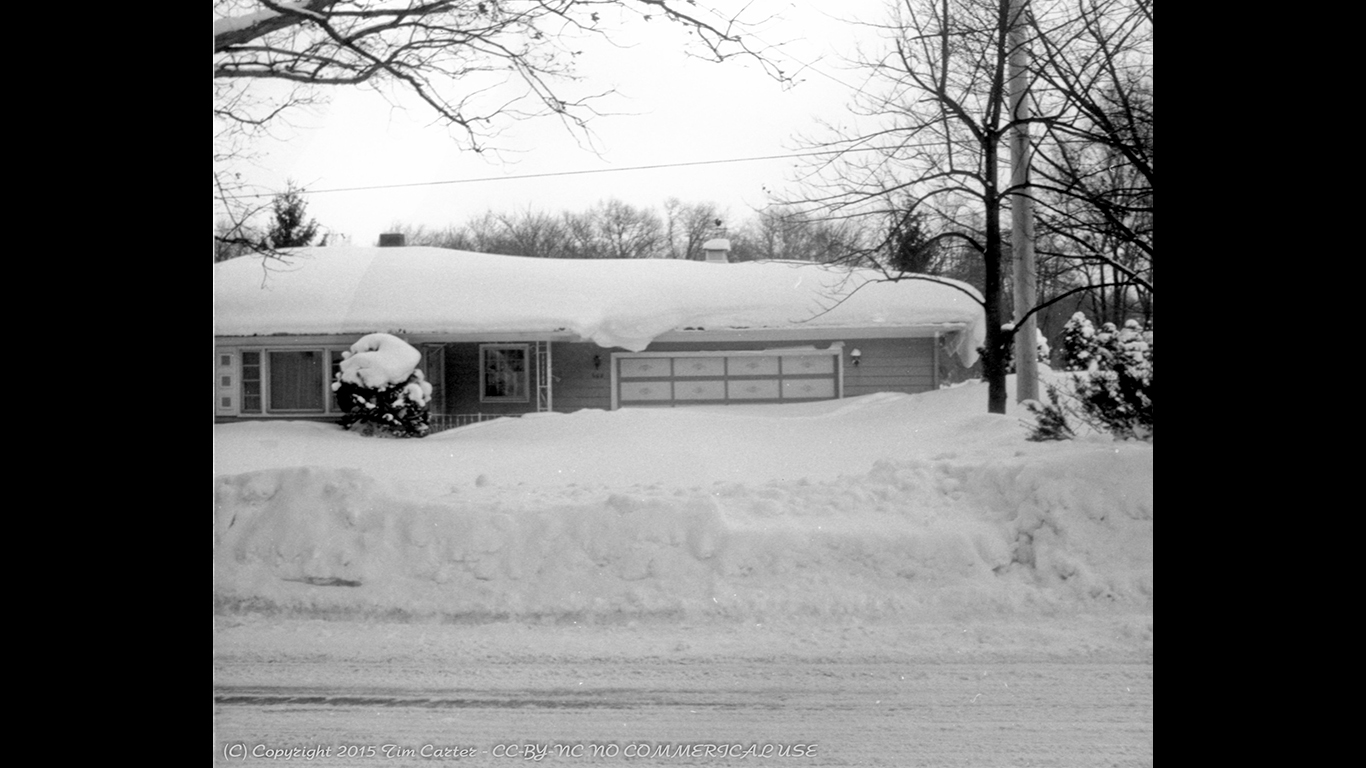
23. Detroit, Michigan
> Total 2018 population: 672,662
> Name of event: The Great Blizzard of 1978
> Fatalities: 20
The Motor City ground to a halt in late January of 1978 because of a blizzard that coated much of Michigan during one of that state’s coldest winters ever.
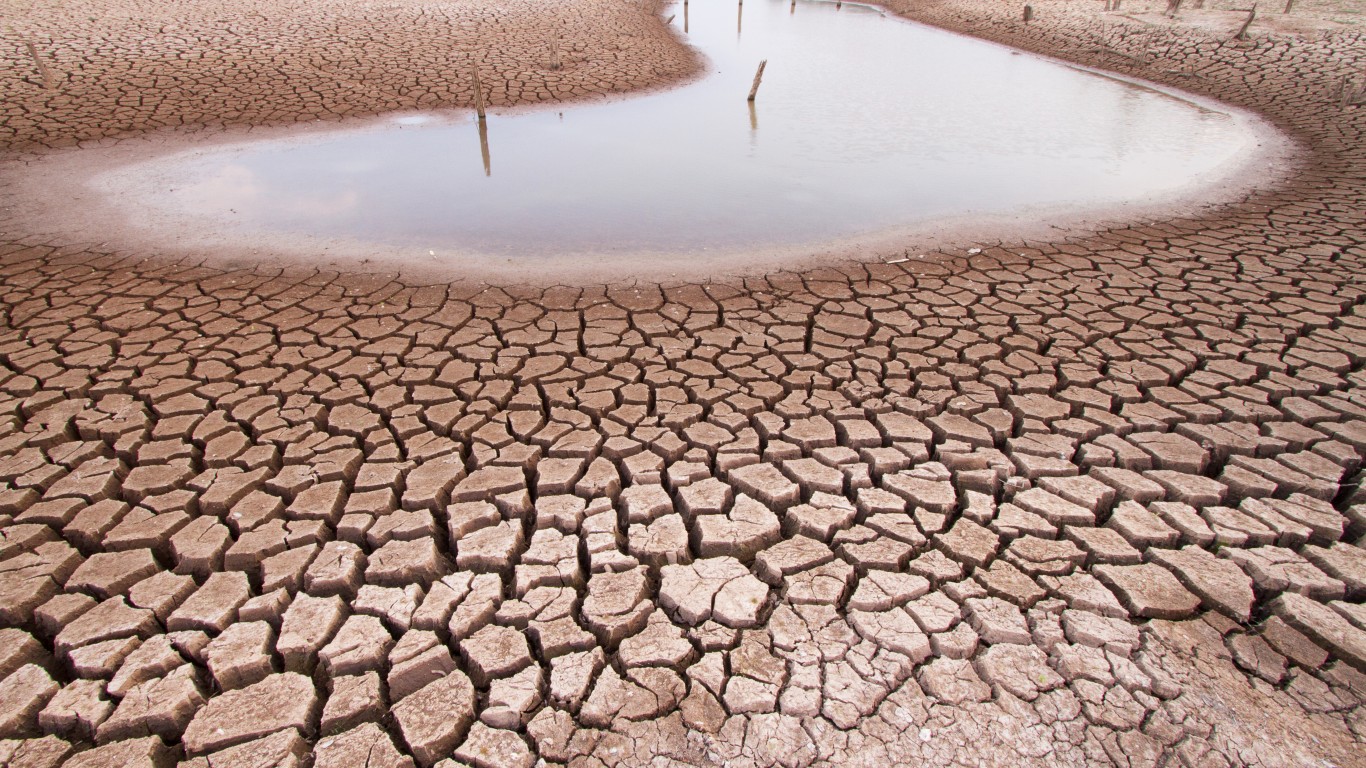
22. El Paso, Texas
> Total 2018 population: 682,669
> Name of event: Drought in 2011
> Fatalities: None
The Texas city on the Mexican border went 119 days without rain, and ranchers had to sell their cattle so they wouldn’t have to watch them die.
[in-text-ad-2]

21. Boston, Massachusetts
> Total 2018 population: 694,583
> Name of event: Great New England Hurricane of 1938
> Fatalities: 700
One of the most powerful hurricanes to strike the New England city blasted the region in September of 1938 with winds of 121 mph, the strongest ever recorded in the area.

20. Washington, District of Columbia
> Total 2018 population: 702,455
> Name of event: The Knickerbocker Storm
> Fatalities: 98
The Knickerbocker Storm of 1922 is named after the tragedy connected with the massive snow storm that hit the nation’s capital in January. The storm caused the collapse of the Knickerbocker Theater that killed 98 people.
[in-text-ad]

19. Denver, Colorado
> Total 2018 population: 716,492
> Name of event: The Hayman Fire
> Fatalities: 6
Arson and severe drought conditions caused the Hayman Fire in July of 2002 that burned more than 138,000 acres.

18. Seattle, Washington
> Total 2018 population: 744,955
> Name of event: Columbus Day storm in 1962
> Fatalities: Dozens killed on West Coast
The state of Washington was inundated with rain and wind on Oct. 12, 1962, that was so heavy that the World’s Fair was forced to close early.
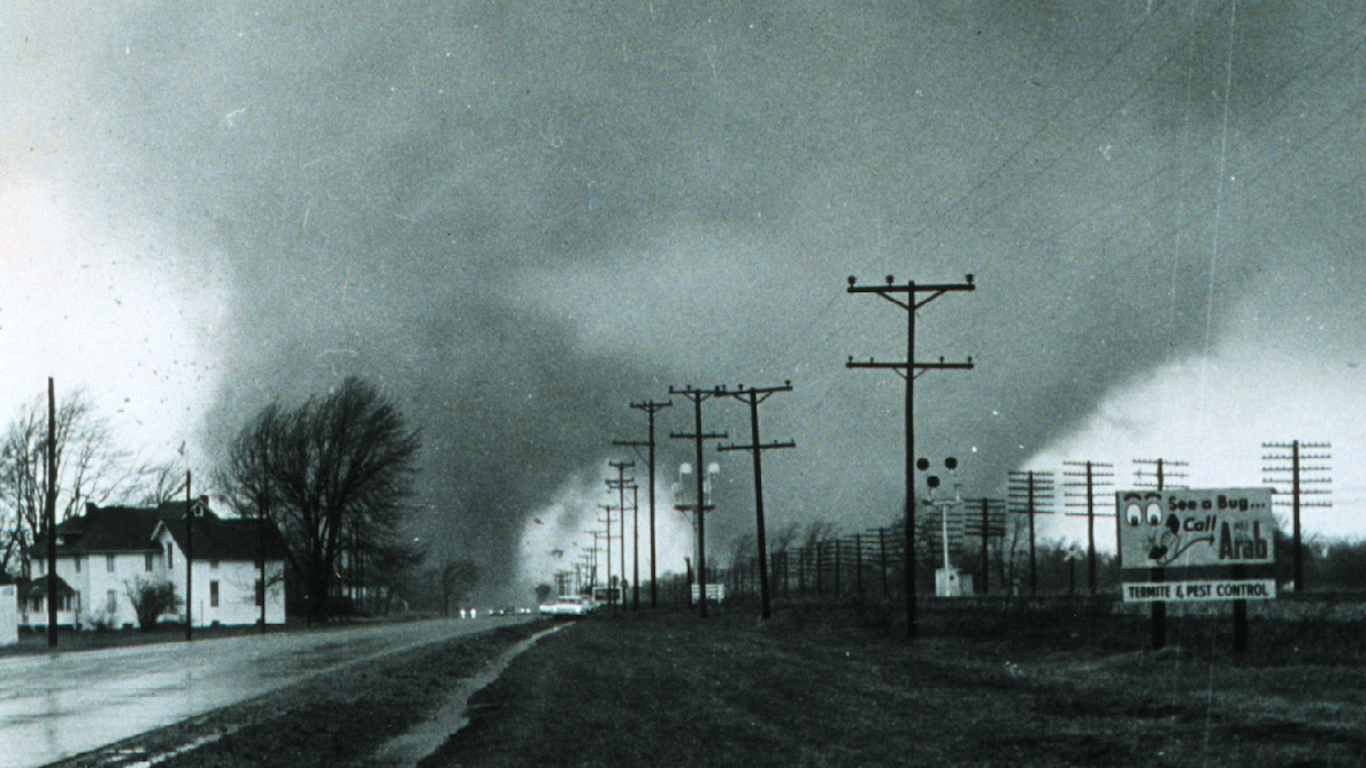
17. Indianapolis, Indiana
> Total 2018 population: 867,125
> Name of event: The Palm Sunday Tornado Outbreak
> Fatalities: 137 in Indiana
An outbreak of 50 tornadoes in the Great Lakes region on April 11-12, 1965, swept up Indiana, where twin twisters touched down near the town of Dunlap.
[in-text-ad-2]
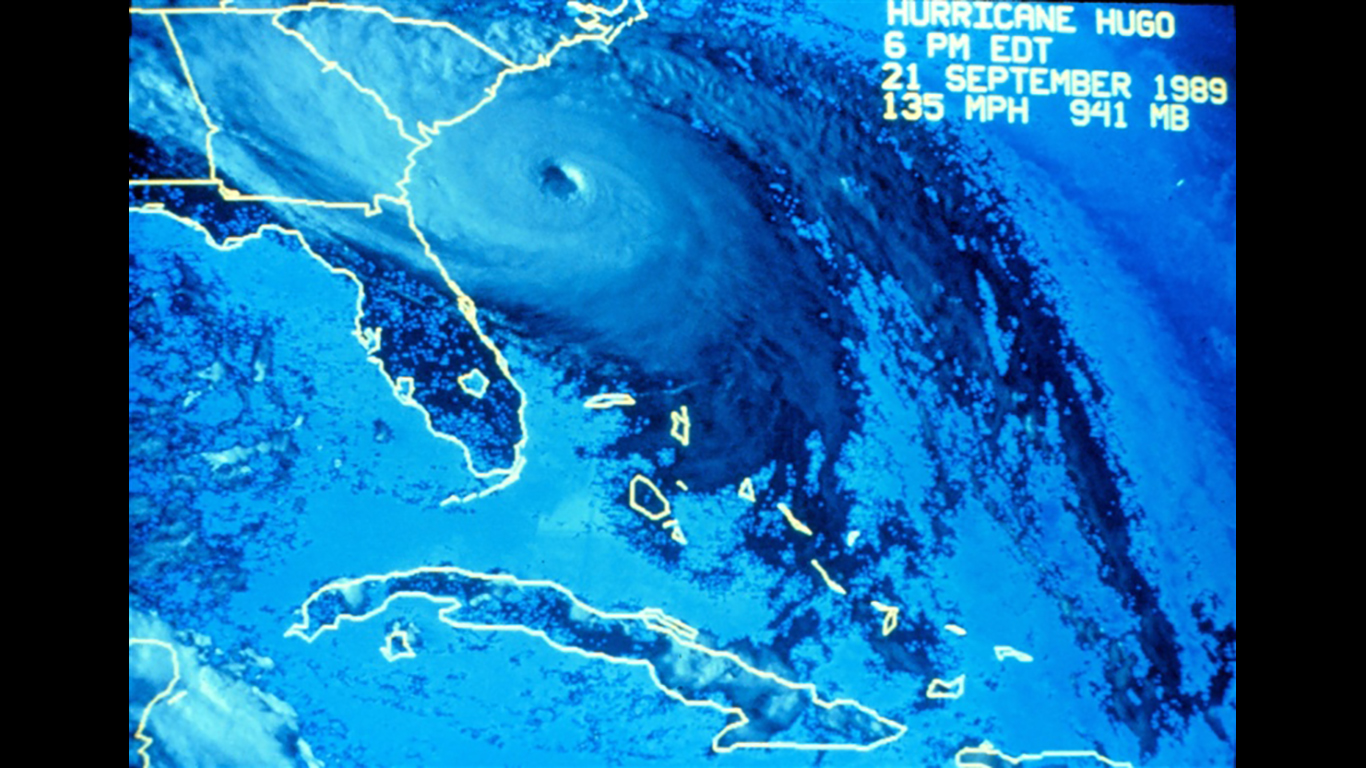
16. Charlotte, North Carolina
> Total 2018 population: 872,498
> Name of event: Hurricane Hugo
> Fatalities: 2
Hurricane Hugo struck Charlotte in September of 1989, leaving 700,000 residents without power for weeks.

15. San Francisco, California
> Total 2018 population: 883,305
> Name of event: Heat wave in 2017
> Fatalities: 14 in Bay Area
Extreme heat and temperatures as high as 100 degrees are not typical in San Francisco. But over Labor Day in 2017, those temperatures were recorded in the Bay Area, resulting in multiple deaths.
[in-text-ad]
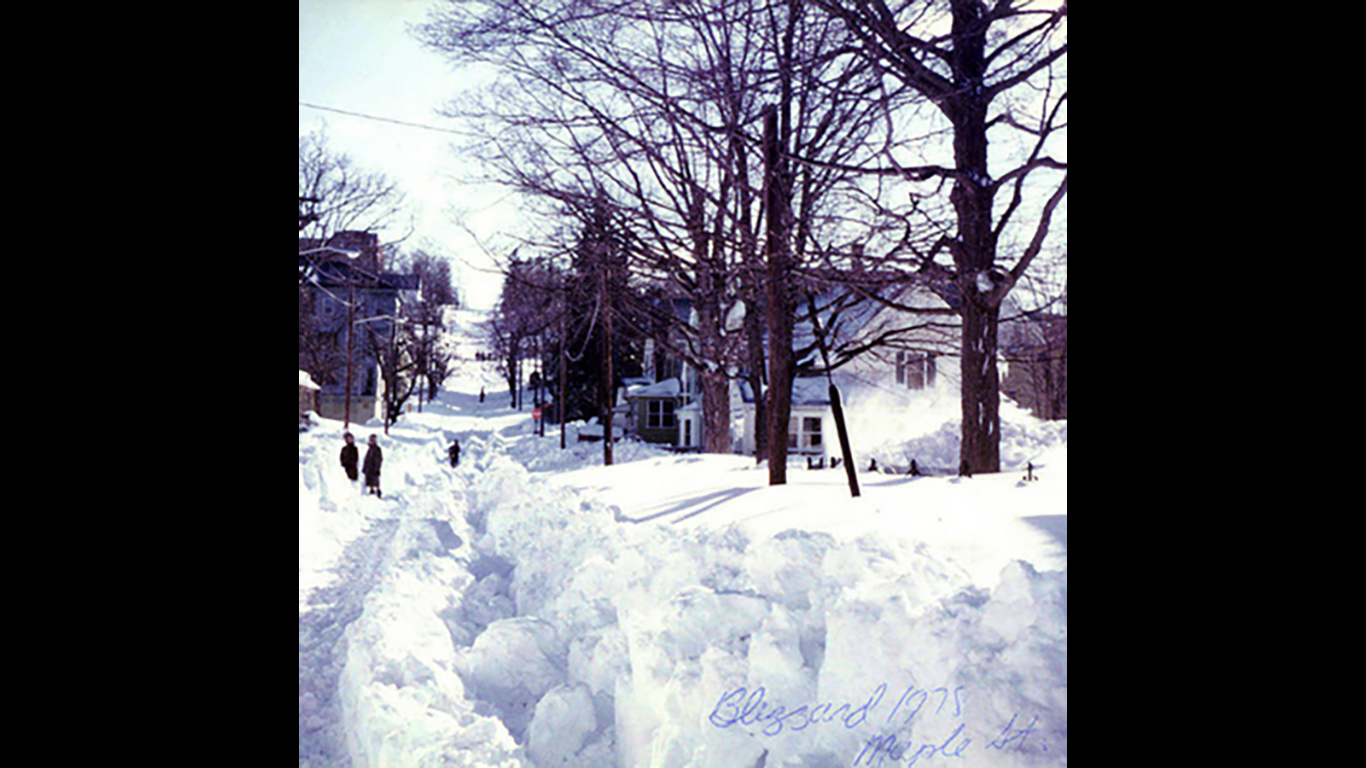
14. Columbus, Ohio
> Total 2018 population: 892,533
> Name of event: The White Hurricane
> Fatalities: 51 in Ohio
In 1978, a blizzard slammed Ohio’s capital city. Wind gusts up to 111 mph were reported and temperatures with wind chill reached lows of 60 below zero. Across Ohio, the storm dubbed “The White Hurricane” killed 51 people.

13. Fort Worth, Texas
> Total 2018 population: 895,008
> Name of event: The 1949 Flood
> Fatalities: 10
In May 1949, more than 10 inches of rain fell on Fort Worth, Texas, causing the Clear Fork River to flood. The flood killed 10 people and forced 13,000 from their homes.

12. Jacksonville, Florida
> Total 2018 population: 903,889
> Name of event: Hurricane Irma in 2017
> Fatalities: 1
Hurricane Irma hit Florida in September 2017 killing one person in Jacksonville and 42 people total across 18 counties.
[in-text-ad-2]
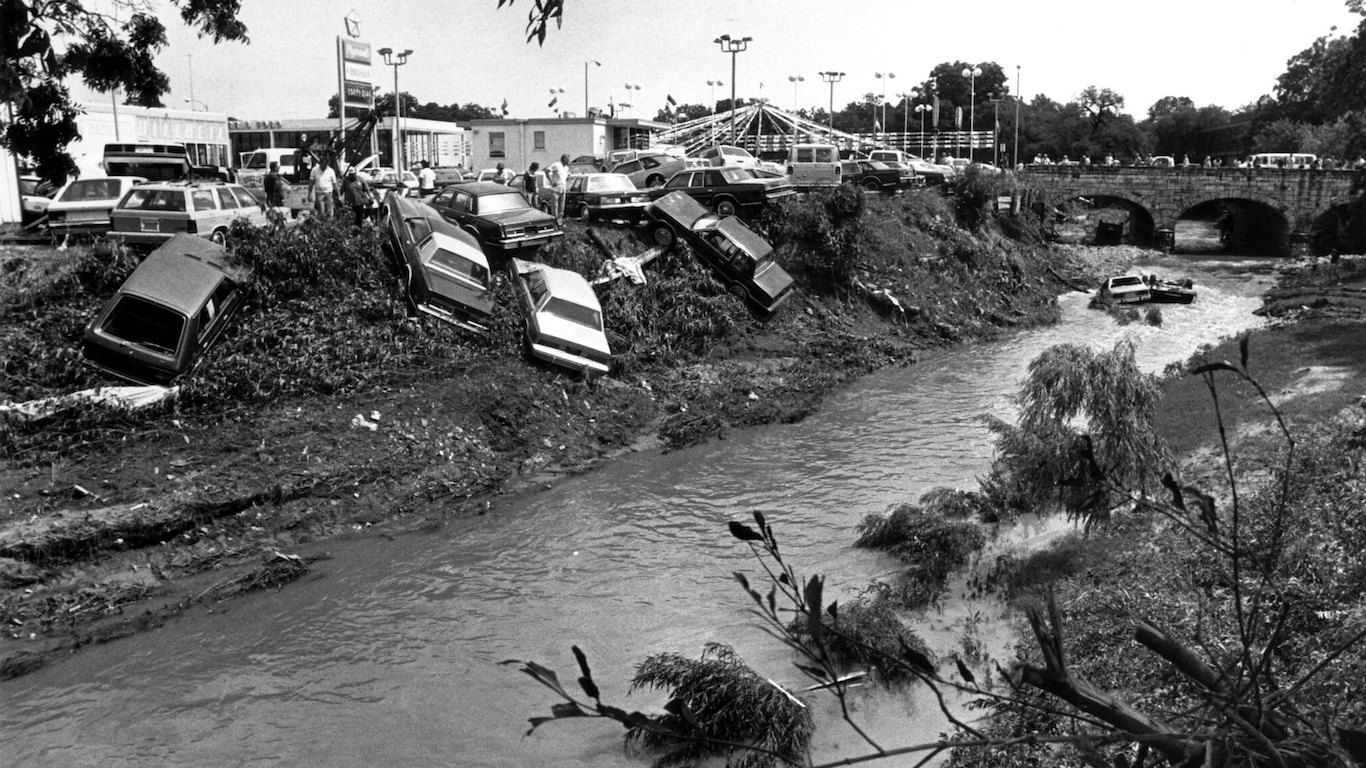
11. Austin, Texas
> Total 2018 population: 964,254
> Name of event: The 1981 Memorial Day Flood
> Fatalities: 13
On Memorial Day 1981, a flood in Austin, Texas, left 13 dead. Torrential rain brought water as high as the ceiling in many residential homes in less than two hours.
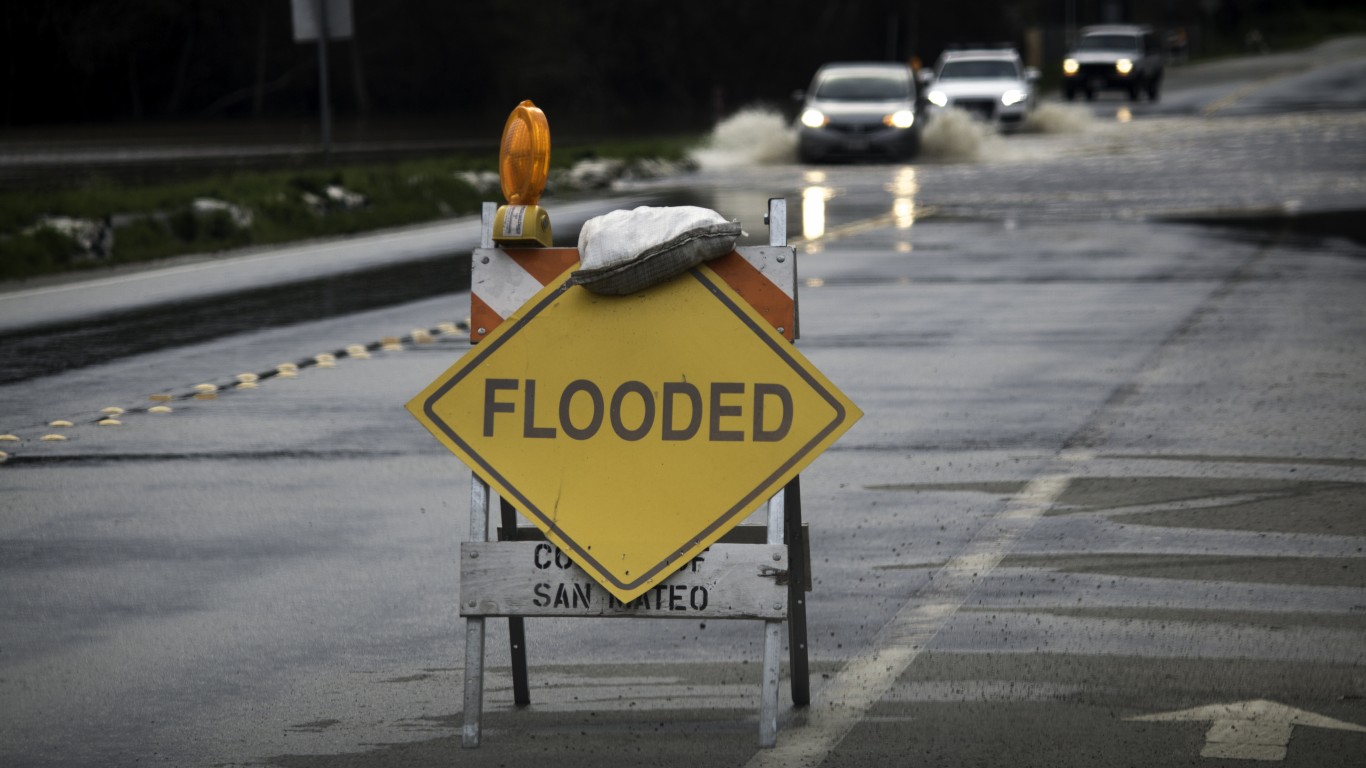
10. San Jose, California
> Total 2018 population: 1,030,119
> Name of event: Flood in 2017
> Fatalities: None
A flood that hit San Jose in February 2017 caught residents off guard as the city failed to notify them of the threat.
[in-text-ad]

9. Dallas, Texas
> Total 2018 population: 1,345,047
> Name of event: The Flood of 1922
> Fatalities: 13
The flood of 1922 claimed more lives in the Dallas-Fort Worth metro area than any other natural disaster in history. Nearly 18 inches of rain fell in the city throughout the month of April. The flooding left 1,000 people homeless and 13 dead.

8. San Diego, California
> Total 2018 population: 1,425,976
> Name of event: The Cedar Fire
> Fatalities: 15
A fire set by a hunter spread out of control in the San Diego area in October 2003. The fire burned over a quarter million acres, destroyed more than 2,800 buildings, and killed 15 people.

7. San Antonio, Texas
> Total 2018 population: 1,532,233
> Name of event: The September 1921 Floods
> Fatalities: 51
In 1921, torrential rain in San Antonio led to flooding that caused $5 million in damage and left 51 people dead.
[in-text-ad-2]

6. Philadelphia, Pennsylvania
> Total 2018 population: 1,584,138
> Name of event: Hurricane Agnes
> Fatalities: 48 in Pennsylvania
Between Florida and New York, Hurricane Agnes dropped 19 inches of rain in June 1972. Pennsylvania was hit particularly hard with the Susquehanna River rising 15 feet above flood stage.

5. Phoenix, Arizona
> Total 2018 population: 1,660,272
> Name of event: Tropical Storm Octave
> Fatalities: 14
In late September and early October of 1983, Tropical Storm Octave dumped more than 6 inches of rain around Phoenix, resulting in the flooding of the Gila River and 14 deaths.
[in-text-ad]

4. Houston, Texas
> Total 2018 population: 2,325,502
> Name of event: Hurricane Rita (Evacuation)
> Fatalities: 107
Unlike most storms on this list, the death toll from Hurricane Rita in 2005 was caused by the response to the storm rather than the storm itself. When 2.5 million residents tried to evacuate the city on the order of officials, gridlock led to 107 deaths — among them 24 elderly people whose bus overheated and caught fire — while the storm itself barely touched Houston.
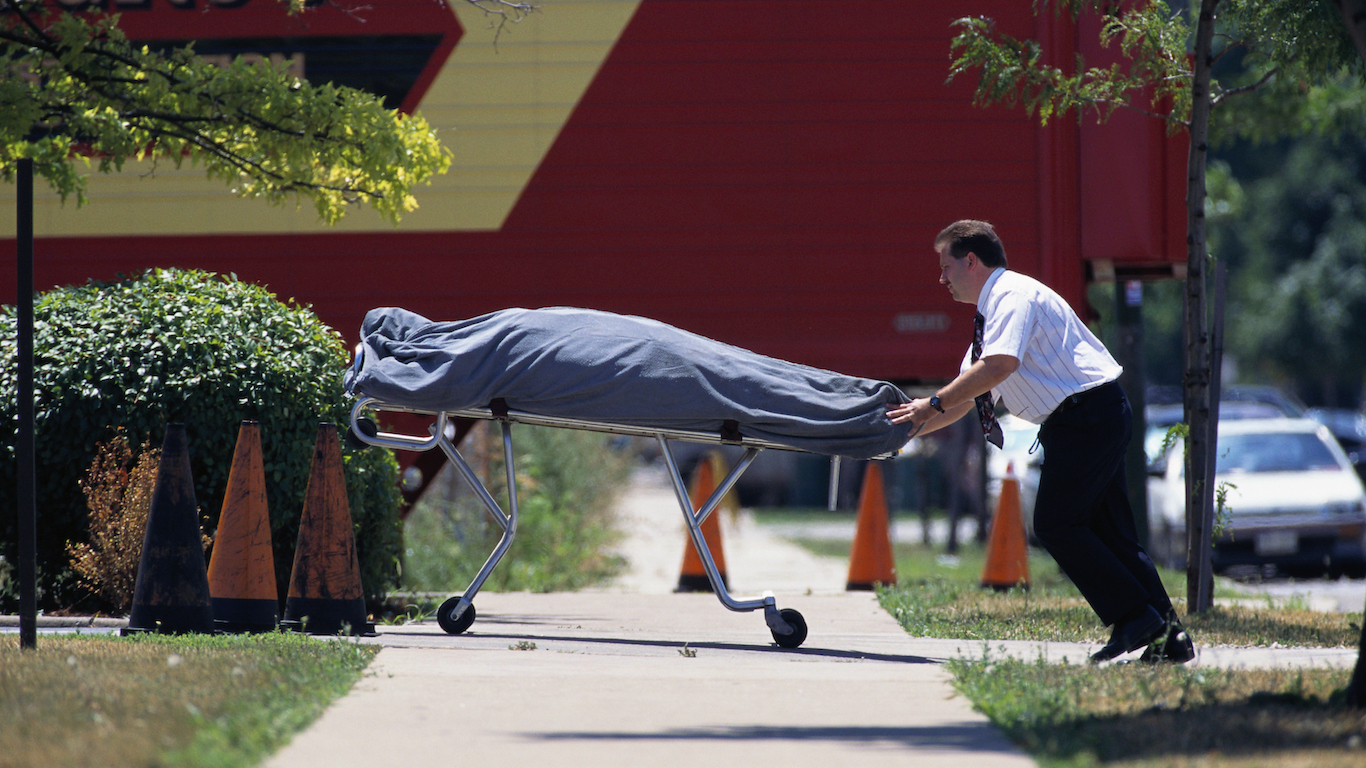
3. Chicago, Illinois
> Total 2018 population: 2,705,994
> Name of event: The 1995 Heat Wave
> Fatalities: 739
In the summer of 1995, a record-breaking heat wave hit Chicago. On July 13, O’Hare Airport reported a record high temperature of 104 degrees.
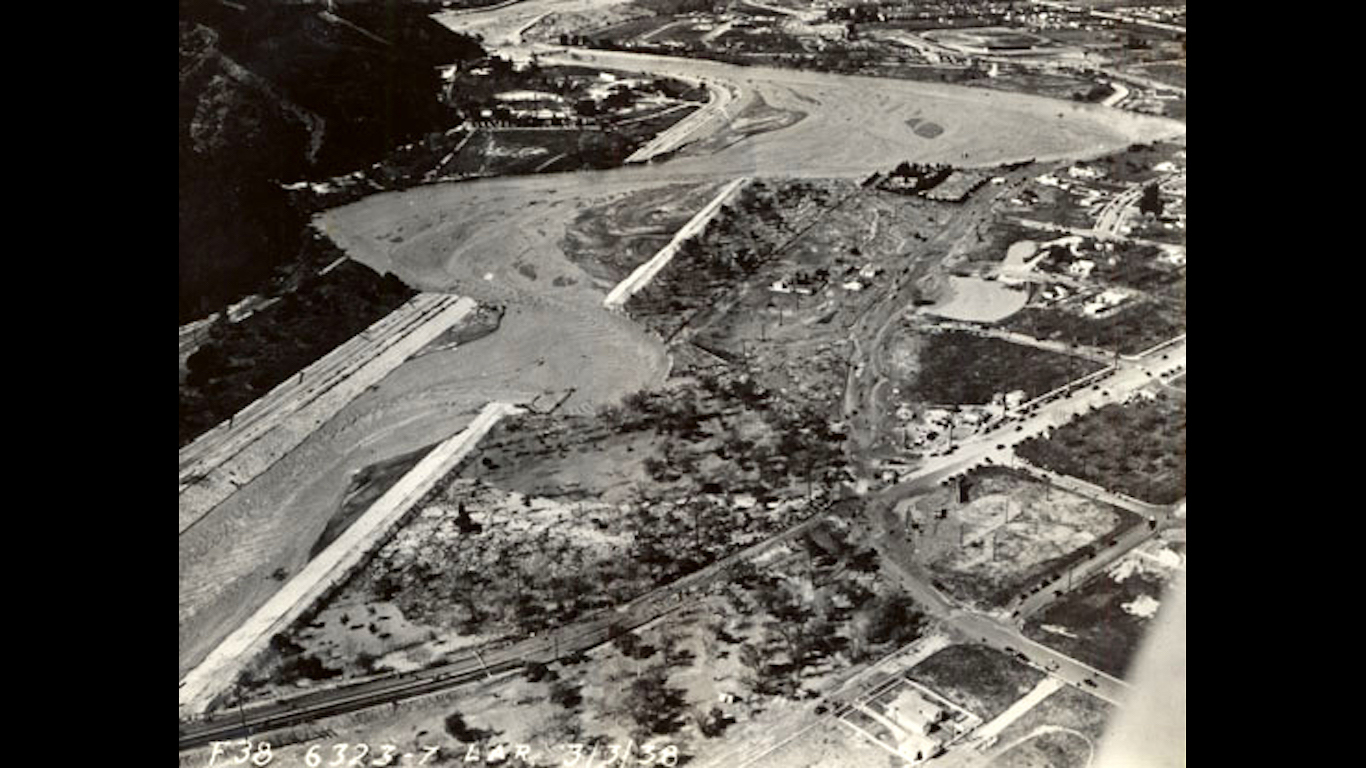
2. Los Angeles, California
> Total 2018 population: 3,990,456
> Name of event: The LA River Flood
> Fatalities: 144
Record-breaking rain from two storm systems hit Southern California, causing the Los Angeles River to flood and destroy homes and bridges in March 1938.
[in-text-ad-2]
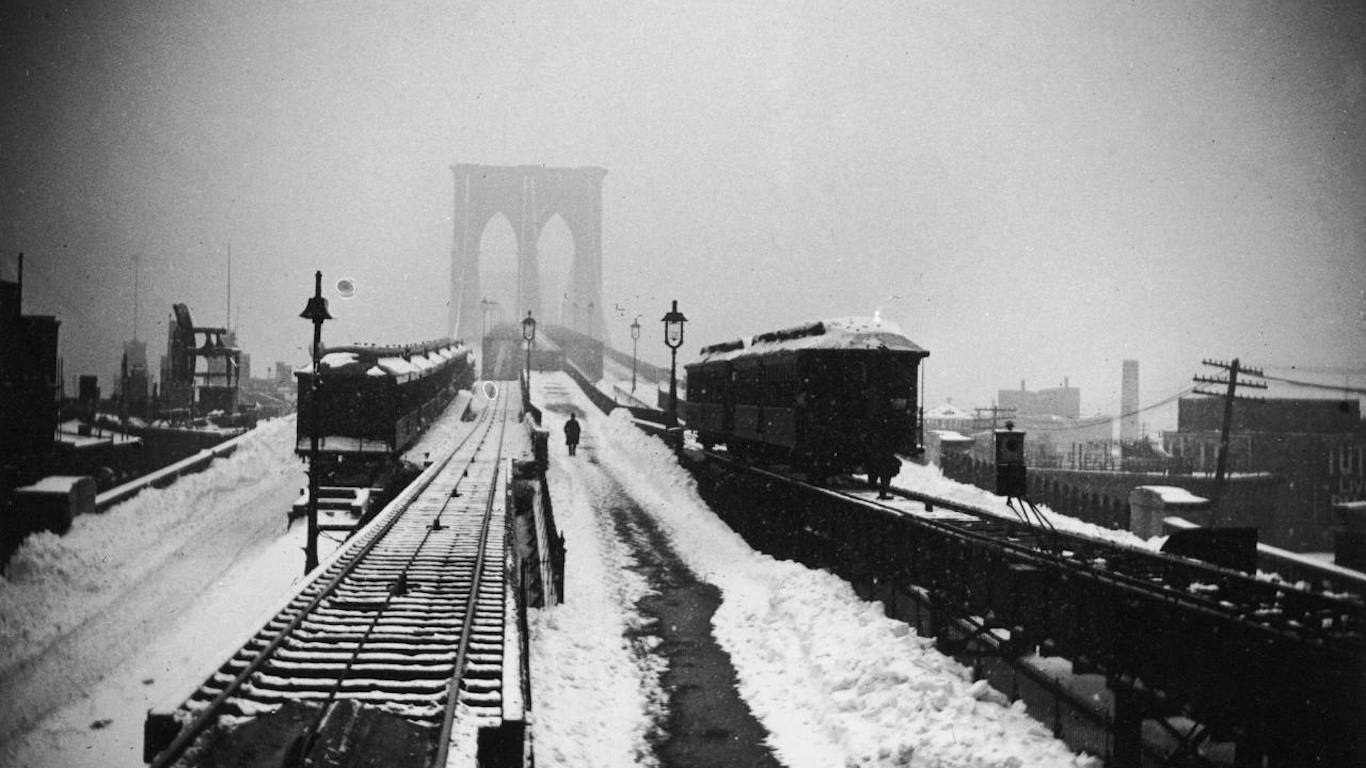
1. New York, New York
> Total 2018 population: 8,398,748
> Name of event: Great Blizzard of 1888
> Fatalities: 200
The Great Blizzard of 1888 affected much of the Eastern Seaboard. New York City reported wind gusts as high as 85 mph, and Wall Street shut down for three consecutive days.
Start by taking a quick retirement quiz from SmartAsset that will match you with up to 3 financial advisors that serve your area and beyond in 5 minutes, or less.
Each advisor has been vetted by SmartAsset and is held to a fiduciary standard to act in your best interests.
Here’s how it works:
1. Answer SmartAsset advisor match quiz
2. Review your pre-screened matches at your leisure. Check out the advisors’ profiles.
3. Speak with advisors at no cost to you. Have an introductory call on the phone or introduction in person and choose whom to work with in the future
Thank you for reading! Have some feedback for us?
Contact the 24/7 Wall St. editorial team.